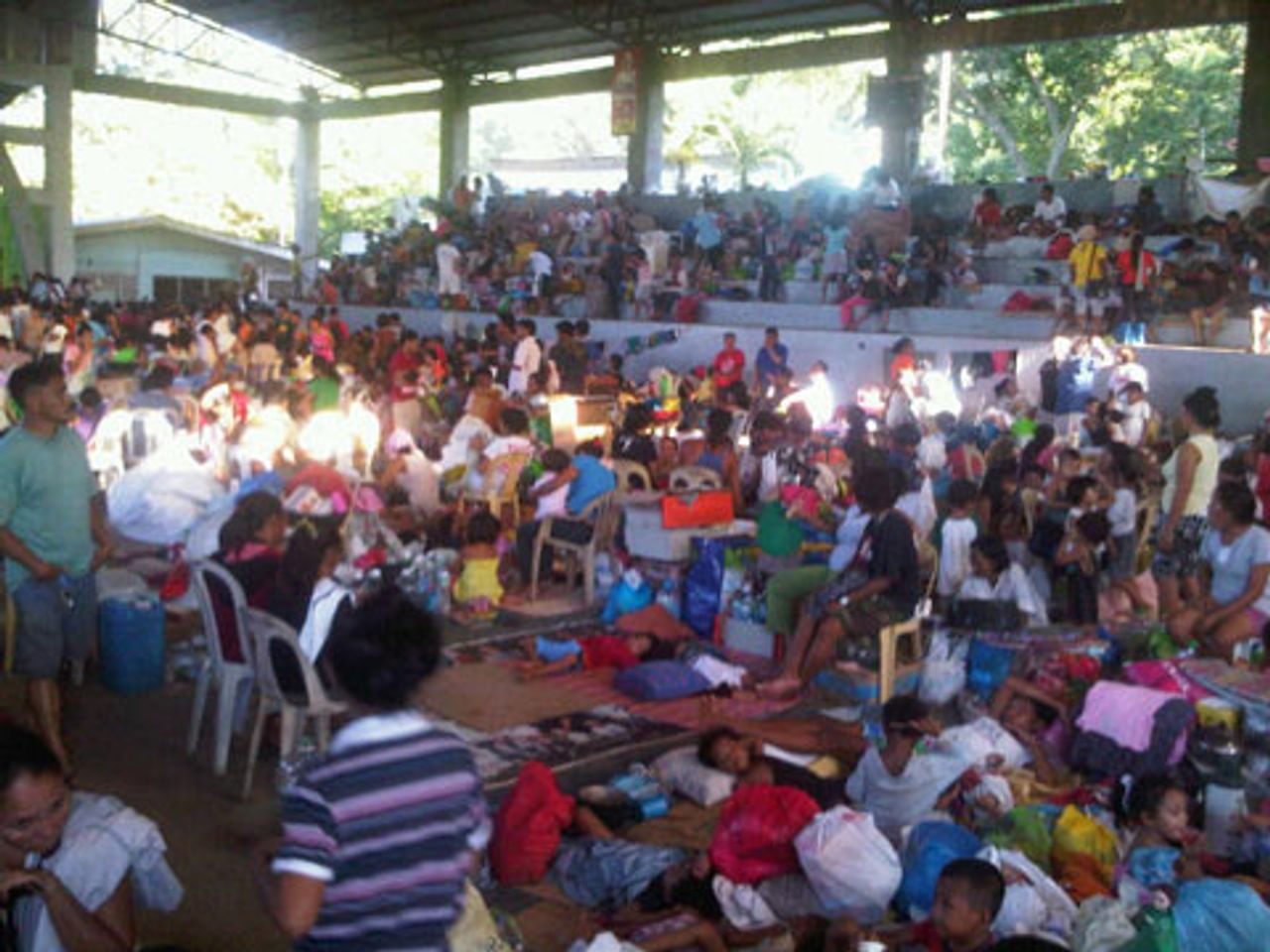The death toll from flash flooding in the Philippines has risen to over 1,000, and hundreds of thousands of people have been displaced. Benito Ramos, head of the Civil Defence Office, told Associated Press that the government had “lost count of the missing.” Reports suggest that the number may be in the hundreds, or thousands.
 Evacuees fill a public gymnasium in Macasandig Village in Cagayan de Oro City. With no running water, this evacuation center is vulnerable to outbreak of diseases. [Photo: Oxfam International]
Evacuees fill a public gymnasium in Macasandig Village in Cagayan de Oro City. With no running water, this evacuation center is vulnerable to outbreak of diseases. [Photo: Oxfam International]The flooding, which began when Tropical Storm Washi struck the southern Philippines last Friday, wiped out entire villages, and destroyed sections of the cities of Iligan and Cagayan de Oro in Northern Mindanao. Floods have also since hit the northern Philippines, killing at least three people and displacing over 50,000.
UN humanitarian coordinator and director for the World Health Organisation in the Philippines, Soe Nyunt-U, described the situation in Iligan and Cagayan de Oro: “It was as if the cities were hit by an inland tsunami. Entire areas were completely flattened; only a few sturdy buildings remain standing.” Former communities were “devoid of all traces of habitation.”
Bloated bodies have begun washing ashore, while mortuaries have been overwhelmed by hundreds of corpses. Government officials said some bodies swept out to sea might never be recovered. An initial decision in Cagayan de Oro to dump unclaimed bodies at a rubbish dump sparked angry reactions.
Cagayan de Oro and Iligan are facing a major humanitarian crisis, with flood victims sleeping on the streets, and lacking adequate food, water and medical supplies. Eighty percent of Cagayan de Oro, a city of over half a million inhabitants, lacks running water, which will not be reconnected for at least a month.
Makeshift evacuation centres in schools and churches are severely under-resourced and overcrowded, prompting fears of an epidemic. Assistant Health Secretary Eric Tayag warned of outbreaks of cholera, leptospirosis, diarrhoea, Hepatitis A, typhoid fever and dysentery. Some evacuation centres housing thousands of people have just one or two toilets.
The worst affected are the poorest layers of society. The majority of the flood victims in Cagayan de Oro are “informal settlers” living in shanty housing on a sandbar in the middle of the flood-prone Cagayan River. Most of the shanty houses, along with their inhabitants, were swept away by the floodwaters.
The government is still discussing the relocation of survivors. The initial plan was for semi-permanent tent housing. However, interior and local government secretary Jesse Robredo admitted that tents would not be “very conducive to a healthy way of living.” President Benigno Aquino has directed police to prevent residents from rebuilding on the sandbar in the Cagayan River. If a “relocation area” is allocated, residents will likely have to build their own housing.
It now appears that the collapse of dams contributed to the severity of the floods, along with deforestation, silting of the rivers and lack of government planning. Science and technology secretary Mario Montejo told the Sun Star: “It is most likely that the flash flood in Cagayan de Oro was caused not only… by the high volume of rain that fell in the watershed but essentially [as a result of] the collapse of dams at the upper part of the river.” While not confirmed, the bursting of the dams would explain why the floods resembled an inland tsunami.
Montejo also revealed that since the 1980s, only four rivers have had sensors installed to measure water-level rises. Representatives of the weather bureau, PAGASA, said lives could have been saved if an automated warning system had been installed along the Cagayan River. Thirteen of the country’s 18 water basins do not have early warning systems. According to PAGASA, rain gauges rather than sensors are used in Mindanao, due to a limited budget.
Flood victims were given no warning of the scale of the impending disaster. Cagayan de Oro's mayor, Vicente Emano, said local officials only found out about the incoming storm from media reports.
The flood disaster threatens to create difficulties for President Aquino, who is waging a campaign to undermine his rivals, including through the prosecution of former President Gloria Arroyo and the impeachment of Chief Justice Renato Corona.
Aquino visited the flood-affected areas Tuesday, in a bid to placate public anger over the government's role in the floods. He promised there would be “no disaster of this magnitude ever again.” However, he conceded: “I can't say that we did everything. We could have done more.” He declared a state of national calamity on Wednesday.
Aquino has ordered an investigation to find out “what went wrong, who was at fault and who should be held accountable.” There are already indications that the inquiry will be a whitewash. Aquino said one of its central purposes would be to examine whether logging bans imposed in February had been violated. Yet it is well known that the limited bans have been rarely, if ever, enforced.
The Philippine Star published reports in August that illegal logging was taking place more or less openly in Lanao del Norte, the province in which Iligan city is located. When government officials were contacted, they refused to comment, and did nothing. Moreover, the presidential advisor on the environment, Nereus Acosta, has already acknowledged that deforestation of watersheds and excessive urbanisation contributed to the severity of the disaster.
The investigation’s only aim is to deflect attention from the responsibility of Aquino and previous administrations for inadequate preventative measures in relation to flooding and other natural disasters. The Philippines is prone to tropical storms, severe flooding and landslides that have produced numerous catastrophes in the past. While the immediate causes lie in the forces of nature, the scale of such tragedies is greatly magnified by the operations of the profit system, which subordinates basic social need to corporate interests.
